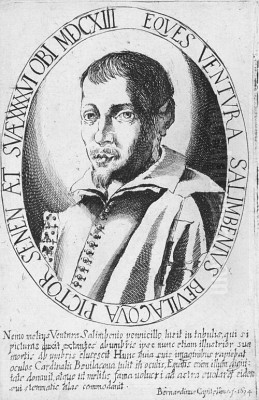
Ventura Salimbeni, also known by his honorific title Cavaliere Bevilacqua, stands as a significant, if sometimes overlooked, figure in the transition from late Mannerism to the early Baroque in Italian art. Born in Siena on January 20, 1568, and dying in the same city in 1613, his relatively short but prolific career left an indelible mark on the artistic landscape of Tuscany and Rome. He is often cited as one of the last great exponents of the Sienese School's distinctive Mannerist style, a tradition with deep historical roots that he both honored and subtly evolved.
Early Life and Artistic Formation in Siena
Ventura Salimbeni was born into an artistic family, a common circumstance for painters of his era. His father, Arcangelo Salimbeni (c. 1536–1580), was a respected Sienese painter whose work, though less renowned than his son's, provided Ventura's initial artistic grounding. Arcangelo's style, itself influenced by earlier Sienese masters like Domenico Beccafumi and Sodoma, as well as contemporary Mannerist trends, would have been the young Ventura's first exposure to the principles of design, color, and composition.
Equally, if not more, influential in his early development was his elder half-brother, Francesco Vanni (1563–1610). Vanni, also a prominent Sienese painter, shared a close artistic and personal bond with Ventura. They likely trained together, and their styles often show remarkable similarities, sometimes leading to attribution difficulties for art historians. Both brothers absorbed the Sienese penchant for elegant, elongated figures, vibrant color palettes, and emotionally charged religious narratives. The artistic environment of Siena, with its rich heritage and active patronage from religious orders and noble families, provided a fertile ground for Salimbeni's burgeoning talent.
The Roman Sojourn: Exposure and Expansion
Around 1588, seeking broader opportunities and exposure to the vibrant artistic currents of the papal city, Ventura Salimbeni moved to Rome. This was a pivotal period for any ambitious Italian artist. Rome was a crucible of artistic innovation, where painters from across Italy and Europe converged, competed, and collaborated. During his Roman years, Salimbeni quickly established himself.
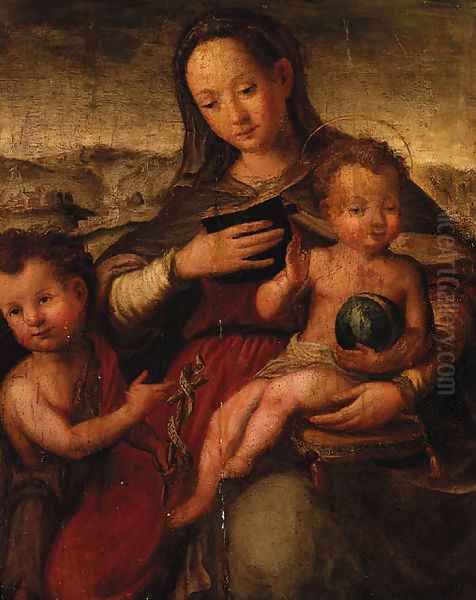
One of his earliest significant commissions in Rome was for the fresco decoration of the Vatican Library, a prestigious project under Pope Sixtus V. Working alongside other artists, Salimbeni contributed to the elaborate visual program designed to celebrate the power and learning of the Church. This experience would have honed his skills in large-scale fresco painting and exposed him to the diverse stylistic approaches of his contemporaries.
During the period 1590-1591, he received important commissions from Cardinal Bonifacio Aldobrandini, who would later become Pope Clement VIII. For the Cardinal, Salimbeni executed works in two of Rome's most important churches: the Gesù, the mother church of the Jesuit order, and the Basilica di Santa Maria Maggiore, one of the city's four major papal basilicas. These commissions underscore his rising status and his ability to secure patronage at the highest levels. His work in Rome shows an assimilation of the prevailing late Mannerist tendencies, characterized by complex compositions, dynamic figures, and a sophisticated use of light and color. He would have been aware of the work of artists like Cristofano Roncalli (Il Pomarancio) and the influential Cavalier d'Arpino (Giuseppe Cesari), who were dominant figures in Rome at the time.
Return to Siena and Mature Career
In 1595, Ventura Salimbeni returned to his native Siena, where he would remain a leading artistic figure for the rest of his life. His Roman experiences had undoubtedly broadened his artistic vocabulary and enhanced his reputation. Back in Siena, he became a key artist in the transition from the established late Renaissance Mannerist style towards the emerging dynamism and emotional intensity of the Baroque.
He undertook numerous commissions for Sienese churches. Notable among these are his frescoes in the Church of Santa Teresa and the Church of Santo Spirito. These works demonstrate his mature style, blending Sienese elegance with Roman grandeur. He also worked in Florence, contributing frescoes to the prestigious Santissima Annunziata, a testament to his reputation extending beyond Siena.
Further Sienese commissions included the "Birth of St. Hyacinth" for the Church of San Domenico and frescoes depicting "Christ Helped by Angels" in the Baptistery of San Giovanni, part of the Siena Cathedral complex. His ability to handle large narrative cycles and individual altarpieces with equal skill made him a sought-after artist. His workshop was active, and he likely employed assistants to help with larger projects, a common practice.
Artistic Style and Influences
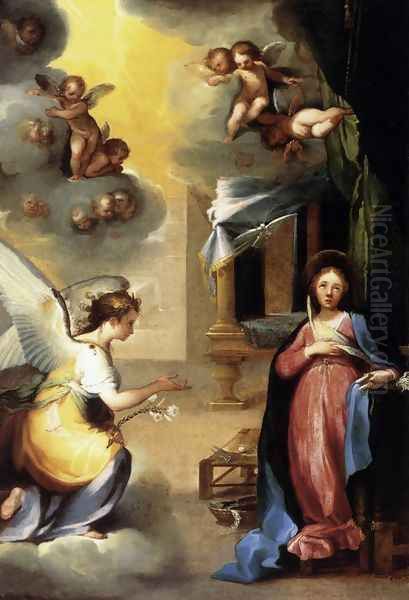
Ventura Salimbeni's art is a fascinating amalgam of influences, rooted in Sienese tradition but responsive to broader Italian trends. The Sienese School, historically, often displayed a more conservative, decorative, and emotionally expressive character compared to the more intellectually rigorous Florentine school. Salimbeni inherited this Sienese predilection for graceful lines and rich color.
The most significant single influence on Salimbeni's mature style was undoubtedly Federico Barocci (c. 1535–1612) of Urbino. Barocci's work, known for its soft, sfumato-like modeling, tender emotionality, and vibrant, almost iridescent colors, deeply resonated with Salimbeni. This influence is evident in Salimbeni's delicate handling of light and shadow, creating a dreamlike, ethereal quality in many of his paintings. His figures often possess a gentle, sweet expressiveness reminiscent of Barocci.
Salimbeni also looked to earlier Sienese masters, particularly Domenico Beccafumi (1486–1551), whose experimental use of light and elongated, often contorted figures were hallmarks of Sienese Mannerism. The influence of Florentine contemporaries like Lodovico Cigoli (1559–1613), who was himself moving towards a more naturalistic and emotionally direct style, can also be discerned, particularly in the growing sense of drama and realism in Salimbeni's later works.
His artistic style is characterized by:
Elongated Figures: Typical of Mannerism, his figures are often slender and graceful, with elegant postures.
Dreamlike Quality: Achieved through soft modeling, subtle light effects, and often idealized settings.
Strong Color Contrasts: While capable of delicate harmonies, he also employed vibrant and sometimes contrasting colors to create dynamic and visually engaging compositions.
Detailed Narrative: His religious scenes are often rich in detail, effectively conveying the story and its emotional import.
Mysticism and Imagination: There's often a sense of otherworldly mystery and a fertile imagination at play in his compositions.
Emotional Expression: Salimbeni excelled at conveying a range of emotions, from tender devotion to profound grief, aligning with the Counter-Reformation's emphasis on art that could move the faithful.
While firmly a late Mannerist, Salimbeni's work shows an awareness of the nascent Baroque, particularly in its increased dynamism, more naturalistic rendering of light, and heightened emotional appeal. He stands as a bridge, embodying the sophisticated elegance of the outgoing style while hinting at the dramatic power of the new.
Key Masterpieces
Ventura Salimbeni produced a considerable body of work, primarily religious altarpieces and frescoes. Several stand out as particularly representative of his skill and style:
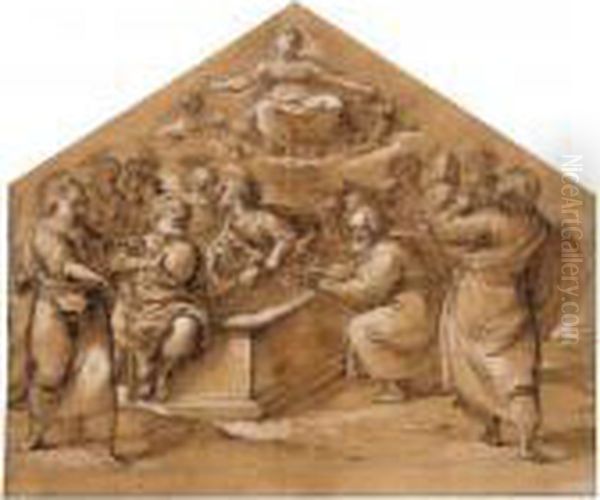
"The Glorification of the Eucharist" (also known as "The Disputation of the Eucharist" or "The Montalcino Trinity"): Perhaps his most discussed work, painted around 1598-1600 for the Church of San Pietro in Montalcino (now in the Church of San Lorenzo in San Pietro, Montalcino). This painting depicts the Holy Trinity – God the Father, Christ, and the Holy Spirit as a dove – above a celestial sphere. The sphere, held by God and Christ, has generated considerable modern speculation due to its metallic appearance and antenna-like protrusions, leading to anachronistic comparisons with satellites like Sputnik. Art historians, however, generally interpret this object as a "Sphaera Mundi" or Creation Globe, a common symbol representing the cosmos or the created world, often depicted with bands and a finial. The painting is a complex theological statement, executed with Salimbeni's characteristic elegance and rich color.
"Madonna and Child with Saints": Salimbeni painted numerous variations on this theme. One notable example, often cited as among his most famous, is the "Madonna and Child with St. Anne and other Saints." These works typically showcase his ability to create tender interactions between the figures, particularly the Virgin and Child, and to render rich fabrics and serene expressions. His depictions of the Madonna often have a gentle, approachable quality.
"The Birth of the Virgin Mary" (Nascita di Santa Maria): Located in the Church of San Domenico in Siena, this work is praised for its sophisticated composition, its handling of flickering light, and its refined surface treatment. It demonstrates Salimbeni's mastery of narrative, presenting the sacred event within a richly detailed domestic interior, a common convention that made such scenes relatable to contemporary viewers.
"The Death of St. Clare": This painting exemplifies Salimbeni's capacity for conveying profound religious emotion and human empathy. The scene of the saint's passing is rendered with a solemn dignity, focusing on the grief and devotion of the surrounding figures. Such works were intended to inspire piety and contemplation.
Frescoes in the Siena Cathedral Complex: His contributions to the Oratory of the Santissima Trinità and the Baptistery of San Giovanni in Siena include scenes from the lives of Sienese saints and martyrs, such as "Diversi Santi della nostra Città" (Various Saints of our City). These large-scale works allowed him to display his skills in complex multi-figure compositions and dynamic storytelling.
"The Marriage of the Virgin" (1612, Diocesan Seminary, Foligno): One of his later works, this painting shows his continued refinement of composition and emotional depth, blending Mannerist elegance with a growing Baroque sensibility.
His oeuvre also includes numerous preparatory drawings, which reveal his meticulous working process and his skill as a draftsman. These drawings, often in pen and ink with wash, are prized for their spontaneity and insight into his creative development of compositions.
Contemporaries, Collaborations, and Artistic Milieu
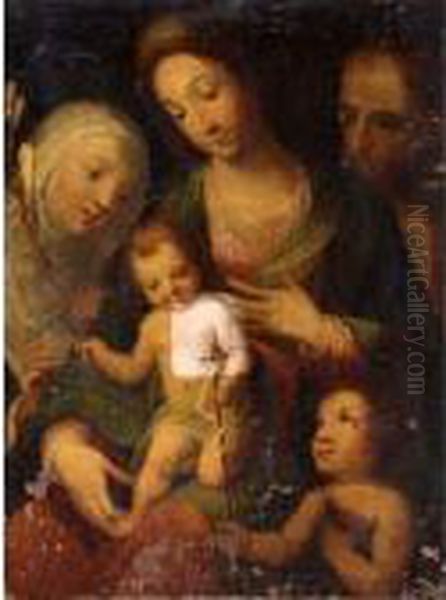
Ventura Salimbeni operated within a rich network of artists, patrons, and religious institutions. His closest artistic relationship was with his half-brother, Francesco Vanni. They often worked in similar circles, sometimes on the same projects, and their styles, while distinct, share a common Sienese heritage and an affinity for the art of Barocci. Their father, Arcangelo Salimbeni, provided their initial training.
In Rome, Salimbeni would have encountered a host of artists. While direct collaborations are not always documented, he was part of a milieu that included figures like Cavalier d'Arpino (Giuseppe Cesari), a leading exponent of late Mannerism, and Cristofano Roncalli (Il Pomarancio). He would also have been aware of the reformist movements in painting led by the Carracci (Annibale, Agostino, and Ludovico), who were advocating for a return to naturalism and classical principles, and the revolutionary naturalism of Caravaggio, whose dramatic use of chiaroscuro was beginning to make waves. While Salimbeni's style remained more aligned with Mannerism, the artistic ferment in Rome undoubtedly left its mark.
His primary influence, Federico Barocci, though based in Urbino, had a wide impact through his paintings and prints, and Salimbeni clearly studied his work intently. In Siena, Salimbeni was a contemporary of other Sienese painters such as Alessandro Casolani (1552/53–1607) and Pietro Sorri (c. 1556–c. 1622). Casolani, in particular, shared some stylistic affinities with Salimbeni and Vanni. Younger Sienese artists like Rutilio Manetti (1571–1639) would have come to maturity seeing the works of Salimbeni and Vanni as dominant examples in their city.
Patronage was crucial. In Rome, Pope Sixtus V and Cardinal Bonifacio Aldobrandini (later Pope Clement VIII) were key figures. In Siena and other Tuscan cities, religious orders (Franciscans, Dominicans, Jesuits), confraternities, and wealthy families provided a steady stream of commissions for altarpieces, frescoes, and private devotional works.
The "Sputnik" Controversy and Salimbeni Family History
The most persistent popular discussion surrounding Ventura Salimbeni centers on his painting "The Glorification of the Eucharist" (or "Montalcino Trinity"). As mentioned, the sphere depicted in the painting has been anachronistically likened to the Soviet satellite Sputnik 1 or even a UFO by some modern observers, fueling theories about ancient astronauts or prophetic visions. Art historians, however, offer more grounded interpretations. The object is widely understood to be a "Sphaera Mundi" (celestial sphere) or Creation Globe, a symbolic representation of the universe or the Earth, often depicted in Trinitarian imagery to signify God's dominion over creation. Such globes frequently featured bands representing celestial equators or meridians, and a finial or axis, which could be misconstrued as antennae by those unfamiliar with the iconography of the period. This interpretation aligns with traditional Christian symbolism and the theological themes common in Counter-Reformation art.
Separately, the broader Salimbeni family, a prominent Sienese clan, has a documented history of involvement in civic and, at times, violent conflicts, particularly during the medieval and early Renaissance periods. For instance, historical records detail feuds between the Salimbeni and other powerful Sienese families, such as the Tolomei, during the 14th century (specifically noted between 1300-1337, with a flashpoint in 1321 when Francesco Salimbeni was killed by Balsino Tolomei, and further escalations in 1322 and 1330). These events, involving power struggles and vendettas, are part of the rich and often turbulent history of Sienese noble families. It is important to note, however, that these specific documented conflicts predate the artist Ventura Salimbeni by several centuries and refer to his ancestors, not his personal life or direct involvement. While family legacy and reputation could carry through generations, these 14th-century events are distinct from the artist's own biography in the late 16th and early 17th centuries.
Legacy and Enduring Influence
Ventura Salimbeni died in Siena in 1613, at the relatively young age of 45. Despite his shortened career, his impact was significant, particularly within the Sienese context. He, along with his half-brother Francesco Vanni, effectively defined the last phase of the independent Sienese Mannerist tradition before it was more fully absorbed into the broader currents of the Italian Baroque.
His influence can be seen in the work of subsequent Sienese painters who would have studied his numerous altarpieces and frescoes in the city's churches. His ability to synthesize the elegance of Mannerism with a burgeoning emotional intensity and a more naturalistic approach to light, partly derived from Barocci, provided a model for artists navigating the stylistic transitions of the early 17th century.
Salimbeni also produced a small number of etchings, contributing to the dissemination of his compositions. His many preparatory drawings are highly valued today, not only for their artistic merit but also as documents of his creative process. They reveal a fluent and inventive draftsman, capable of capturing dynamic movement and subtle emotion with calligraphic grace.
While perhaps not as revolutionary as Caravaggio or as classically influential as the Carracci, Ventura Salimbeni holds an important place in the history of Italian art. He was a master of his craft, a sensitive interpreter of religious themes, and a key figure in the artistic life of Siena and Rome at a time of profound stylistic change. His work embodies the refined, spiritual, and often dreamlike qualities of late Mannerism, while also looking forward to the more dramatic and engaging art of the Baroque era.
Conclusion
Ventura Salimbeni remains a testament to the enduring vitality of the Sienese artistic tradition even as it approached its final distinct chapter. His paintings, characterized by their elegant figures, luminous color, and heartfelt emotion, continue to resonate with viewers. As a bridge between two major artistic epochs, and as a master who skillfully blended diverse influences into a personal and recognizable style, Salimbeni's contributions to late 16th and early 17th-century Italian art are worthy of continued study and appreciation. His legacy is preserved in the churches and museums of Tuscany and beyond, a reminder of a gifted artist who navigated a period of profound artistic transformation with grace and skill.